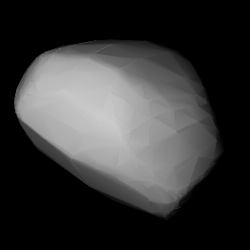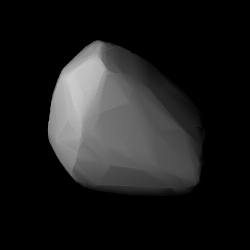(65407) 2002 RP120, provisional designation 2002 RP120, is a trans-Neptunian object and damocloid from the outer Solar System. Its orbit is retrograde and comet-like, and has a high eccentricity. It was discovered on 4 September 2002 by astronomers with the LONEOS survey at Anderson Mesa Station, Arizona, in the United States. The unusual object measures approximately 14.6 kilometers (9.1 miles) in diameter and is likely elongated in shape. It is a slow rotator and potentially a tumbler as well. The object was probably ejected from the ecliptic by Neptune.
34351 Decatur, provisional designation 2000 RZ8, is a Koronis asteroid from the outer region of the asteroid belt, approximately 3.5 kilometers (2.2 miles) in diameter. It was discovered on 3 September 2000, by American amateur astronomer Loren Ball at his Emerald Lane Observatory in Alabama, United States. The Q-type asteroid was named after the city of Decatur, location of the discovering observatory.

3749 Balam is a stony Flora asteroid and rare trinary system orbiting in the inner regions of asteroid belt. It also forms a secured asteroid pair with sub-kilometer sized asteroid (312497) 2009 BR60. Balam was discovered on 24 January 1982, by American astronomer Edward Bowell at Lowell's Anderson Mesa Station near Flagstaff, Arizona, and received the prov. designation 1982 BG1. It was named after Canadian astronomer David Balam. Balam measures approximately 4.1 kilometers (2.5 miles) in diameter. Its two minor-planet moons have an estimated diameter of 1.66 and 1.84 kilometers, respectively.

77185 Cherryh, provisional designation 2001 FE9, is a background asteroid from the central regions of the asteroid belt, approximately 4 kilometers (2.5 miles) in diameter. It was discovered on 20 March 2001, by American amateur astronomers Don Wells and Alex Cruz at the George Observatory in Needville, Texas. The dark asteroid was named for American writer C. J. Cherryh.
151997 Bauhinia, provisional designation 2004 JL1, is a sub-kilometer background asteroid from the inner regions of the asteroid belt, approximately 900 meters in diameter. It was discovered on 11 May 2004, by Canadian astronomer William Yeung at the Desert Eagle Observatory, Arizona, United States. It was named after the flowering plant Bauhinia blakeana also known as the "Hong Kong Orchid Tree".
17198 Gorjup, provisional designation 2000 AA31, is a stony Flora asteroid and asteroid pair from the inner regions of the asteroid belt, approximately 2.7 kilometers in diameter. It was discovered on 3 January 2000, by the Lincoln Near-Earth Asteroid Research team at the Lincoln Laboratory Experimental Test Site in Socorro, New Mexico, United States. The asteroid was named for Slovenian Niko Gorjup, a 2003 awardee of the ISEF contest.

5026 Martes (prov. designation: 1987 QL1) is a carbonaceous asteroid from the inner region of the asteroid belt, approximately 9 kilometers (6 miles) in diameter. It was discovered on 22 August 1987, by Czech astronomer Antonín Mrkos at Kleť Observatory in the Czech Republic. It is named after the two weasel-like animal species: pine marten and beech marten.

6070 Rheinland (prov. designation: 1991 XO1) is a paired Nysian asteroid from the inner regions of the asteroid belt, approximately 4.4 kilometers (2.7 miles) in diameter. It was discovered on 10 December 1991, by German astronomer Freimut Börngen at the Karl Schwarzschild Observatory in Tautenburg, Germany. The asteroid was named after the Rhineland, a region in western Germany. The stony asteroid has a rotation period of 4.27 hours.

4765 Wasserburg (prov. designation: 1986 JN1) is a bright Hungaria asteroid, suspected binary system and asteroid pair from the innermost regions of the asteroid belt, approximately 3 kilometers (1.9 miles) in diameter. It was discovered on 5 May 1986, by American astronomer Carolyn Shoemaker at Palomar Observatory, and later named after geologist Gerald J. Wasserburg.
37432 Piszkéstető, provisional designation 2002 AE11, is an Erigonian asteroid from the inner regions of the asteroid belt, approximately 4.6 kilometers (2.9 miles) in diameter. It was discovered on 11 January 2002, by the Hungarian astronomers Krisztián Sárneczky and Zsuzsanna Heiner at the Konkoly Observatory's Piszkéstető Station northeast of Budapest, Hungary. The asteroid was later named for the discovering observatory.
185638 Erwinschwab, provisional designation 2008 EU7, is a potentially sub-kilometer Nysian asteroid from the inner regions of the asteroid belt. It was discovered on 1 March 2008, by OAM-astronomers at the La Sagra Observatory in southern Spain. The asteroid is estimated to measure between 950 meters and 1.8 kilometers in diameter and was named after German astronomer Erwin Schwab in 2009.
20325 Julianoey, provisional designation 1998 HO27, is a Vestian asteroid and a synchronous binary system from the inner regions of the asteroid belt, approximately 5 kilometers (3 miles) in diameter. It was discovered on 21 April 1998, by astronomers of the Spacewatch survey at Kitt Peak National Observatory near Tucson, Arizona. The asteroid was named after Australian photometrist Julian Oey. The discovery of its minor-planet moon was announced in December 2014.

22899 Alconrad, provisional designation 1999 TO14, is a Koronian asteroid and binary system from the outer region of the asteroid belt, approximately 5 kilometers in diameter. It was discovered on 11 October 1999, by Croatian astronomers Korado Korlević and Mario Jurić at the Višnjan Observatory, Croatia.
32008 Adriángalád, provisional designation: 2000 HM53, is a background asteroid and synchronous binary system from the inner regions of the asteroid belt, approximately 4 kilometers (2.5 miles) in diameter. It was discovered on 29 April 2000, by astronomers with the LINEAR program at Lincoln Laboratory's Experimental Test Site near Socorro, New Mexico, in the United States. The V-type asteroid has a rotation period of 3.0 hours. It was named for Slovak astronomer Adrián Galád. Its 1.6-kilometer sized minor-planet moon was discovered in August 2007.
50719 Elizabethgriffin, provisional designation 2000 EG140, is a stony Maria asteroid and exceptionally slow rotator from the central region of the asteroid belt, approximately 3.3 kilometers (2.1 miles) in diameter. It was discovered on 1 March 2000, by astronomers with the Catalina Sky Survey at Mount Lemmon Observatory, Arizona, United States. It was named for Canadian astronomer Elizabeth Griffin.

(300163) 2006 VW139, provisional designations 2006 VW139 and P/2006 VW139, as well as periodic cometary number 288P, is a kilometer-sized asteroid from the outer regions of the asteroid belt and the first "binary main-belt comet" ever discovered.
(457175) 2008 GO98, provisional designation 2008 GO98 with cometary number 362P, is a Jupiter family comet in a quasi-Hilda orbit within the outermost regions of the asteroid belt. It was discovered on 8 April 2008, by astronomers of the Spacewatch program at Kitt Peak National Observatory near Tucson, Arizona, in the United States. This presumably carbonaceous body has a diameter of approximately 15 kilometers (9 miles) and rotation period of 10.7 hours.
2017 SN16, is a sub-kilometer asteroid, classified as a near-Earth object of the Apollo group, approximately 90 meters (300 feet) in diameter. The object was first observed on 24 September 2017, by cometary discoverer Alex Gibbs with the Mount Lemmon Survey at Mount Lemmon Observatory, Arizona, in the United States. It forms an asteroid pair with 2018 RY7 and is currently trapped in a 3:5 mean motion resonance with Venus.

P/2016 J1 (PanSTARRS) is a pair of active main-belt asteroids that split apart from each other in early 2010. The brightest and largest component of the pair, P/2016 J1-A, was discovered first by the Pan-STARRS 1 survey at Haleakalā Observatory on 5 May 2016. Follow-up observations by the Canada-France-Hawaii Telescope at Mauna Kea Observatory discovered the second component, P/2016 J1-B, on 6 May 2016. Both asteroids are smaller than 1 kilometre (0.62 mi) in diameter, with P/2016 J1-A being roughly 0.6 km (0.37 mi) in diameter and P/2016 J1-B being roughly 0.3 km (0.19 mi) in diameter. The two components recurrently exhibit cometary activity as they approach the Sun near perihelion, suggesting that their activity is driven by sublimation of volatile compounds such as water.

152830 Dinkinesh (provisional designation 1999 VD57) is a binary main-belt asteroid about 790 meters (2,600 feet) in diameter. It was discovered by the Lincoln Near-Earth Asteroid Research (LINEAR) survey at Socorro, New Mexico on 4 November 1999. Dinkinesh, the name borrowed from an Ethiopian word for the Lucy fossil, was the first flyby target of NASA's Lucy mission, which approached 425 km (264 mi) from the asteroid on 1 November 2023. During the flyby, the Lucy spacecraft discovered that Dinkinesh has a contact-binary natural satellite named Selam, which is 220 meters (720 ft) in diameter. Dinkinesh is the smallest main-belt asteroid explored by spacecraft yet, though some smaller near-Earth asteroids have also been explored.











